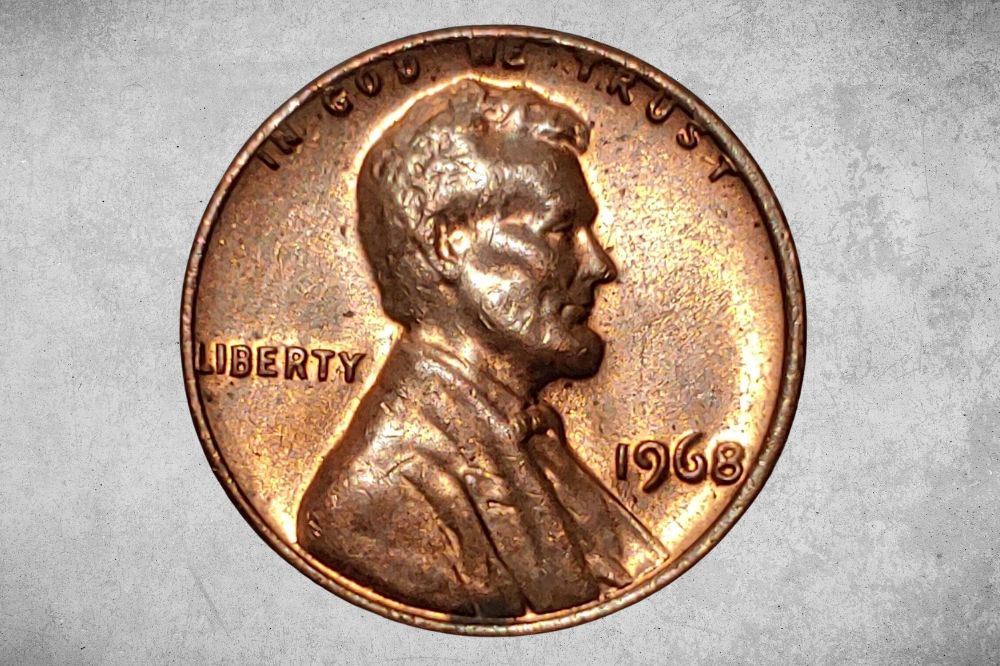The penny has been a mainstay of American money for a very long time, and for collectors, each one is a tiny piece of history. But, among the several millions of pennies that have been produced over the years, just a handful stand out as valuable collectibles.
The 1968 pennies is one such penny that has caught the interest of collectors and enthusiasts. The 1968 penny has grown to be a prized item for those who are aware of its secrets due to its extraordinary worth and distinctive qualities. We’ll examine the 1968 penny’s worth and history in more detail in this article as we discover what makes this modest coin such an intriguing piece of numismatic folklore.
1968 Penny Value Details
- Denomination: One cent
- Composition: 95% copper, 5% zinc
- Weight: 3.11 grams
- Diameter: 19.05 mm
- Edge: Plain
- Designer: Victor D. Brenner (obverse), Frank Gasparro (reverse)
- Minted in: Philadelphia, Denver, and San Francisco
- Total mintage: 4,235,576,000
The 1968 penny, a one-cent coin, is frequently disregarded despite its historical relevance and popularity among coin collectors. The penny stands out from other coins thanks to its distinctive reddish-brown tint, which is due to its composition of 95% copper and 5% zinc. It is a small and distinctive coin that weighs 3.11 grams and is 19.05 mm in diameter.
The 1968 penny’s obverse displays an image of Abraham Lincoln, the 16th president of the United States, and was created by Victor D. Brenner. Frank Gasparro created the Lincoln Monument image on the penny’s reverse. The penny has a basic edge that gives it a straightforward yet enduring appearance.
Philadelphia, Denver, and San Francisco were the three distinct places where the 1968 penny was struck. The penny is not very rare, with a total mintage of 4,235,576,000, but its distinctive shape and content make it an attractive addition to many coin collections.
The 1968 penny is a cherished piece of money and a vital part of American history despite its diminutive size and ostensibly insignificant value.
1968 Penny Value Chart |
||||
| Mint Mark | Good | Fine | Extremely Fine | Uncirculated |
| 1968 No Mint Mark Penny Value | $0.01 | $0.05 | $0.15 | $0.15 |
| 1968 Denver Mint Mark Penny Value | $0.01 | $0.02 | $0.05 | $0.15 |
| 1968 San Francisco Mint Mark Penny Value | $0.01 | $0.03 | $0.10 | $0.20 |
1968 Penny Value and Varieties Guides
1968 No Mint Mark Penny Value
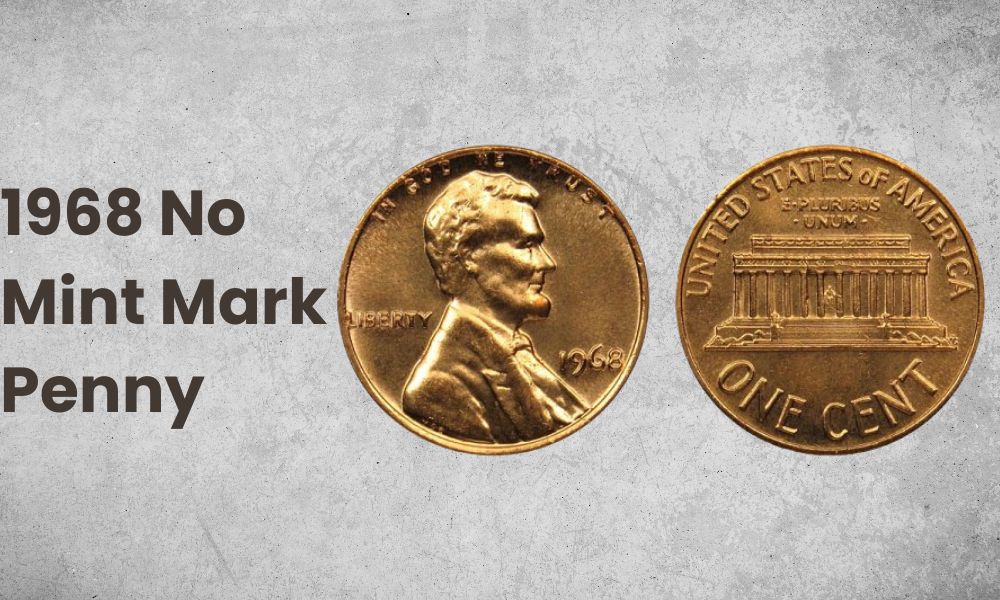
- Type: Penny
- Mark Category: No Mint Mark
- Materials: 95% copper, 5% zinc
- Edge: Plain
- Mint Mark: None
- Place of Minting: Philadelphia
- Year of Minting: 1968
- Face Value: $0.01
- Price: From $0.01 to $0.15
- Quantity: 1,707,880,970
- Designer: Victor D. Brenner (obverse), Frank Gasparro (reverse)
- Mass: 3.11 grams
- Diameter: 19.05 mm
With a total of 1,707,880,970 coins created in 1968, the Philadelphia mint produced a lot of the penny without a mint mark. This coin, which has a face value of just $0.01, is regularly used for small transactions and is available in general circulation. Although it lacks distinctive characteristics like a mint mark, there are several variances and errors that might raise the value of the coin, such as double die errors, repunched mint marks, and changes in the composition of the coin.
A 1968 no-mint mark penny’s worth might change according to things like condition, grade, and rarity. Coins in acceptable condition can often be purchased for between $0.01 and $0.15, while uncommon varieties and mistakes can command significantly higher prices.
1968 Denver Mint Mark Penny Value
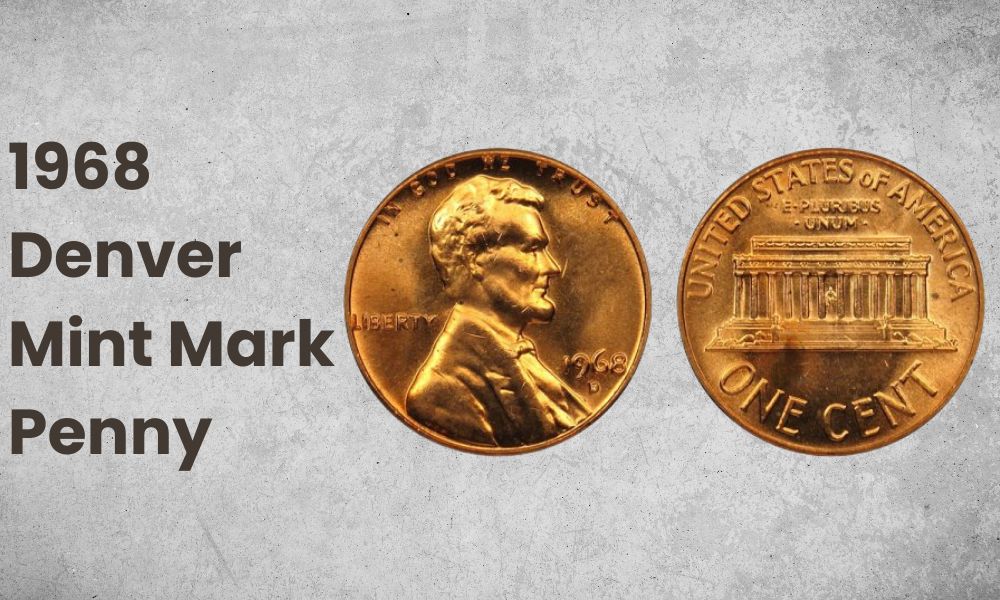
- Type: Penny
- Mark Category: ‘D’ Denver Mint Mark
- Materials: 95% copper, 5% zinc
- Edge: Plain
- Mint Mark: “D” for Denver
- Place of Minting: United States
- Year of Minting: 1968
- Face Value: $0.01
- Price: $0.01 to $0.15
- Quantity: 2,886,075,000 minted
- Designer: Victor D. Brenner (obverse), Frank Gasparro (reverse)
- Mass: 3.11 grams
- Diameter: 19.05 mm
A common coin produced in the United States in 1968 is the Denver Mint Mark Penny. This coin has a face value of just $0.01, so it doesn’t have much value on its own, but it might be worth more if it’s in good shape. The coin has the Denver “D” mint mark to identify its place of manufacture.
There were 2,886,075,000 Denver Mint Mark Pennies made in 1968, making them rather common today. The price of the coin, however, can vary from about $0.01 for a coin in poor condition to as much as $0.15 for a coin that is well-preserved and high-grade.
The rarity, condition, and historical significance of the 1968 Denver Mint Mark Penny, as with all coins, have an impact on its value. The value of the coin may rise as a result of collectors seeking out particular variants, such as double die faults or coins with other intriguing characteristics.
1968 San Francisco Mint Mark Penny Value
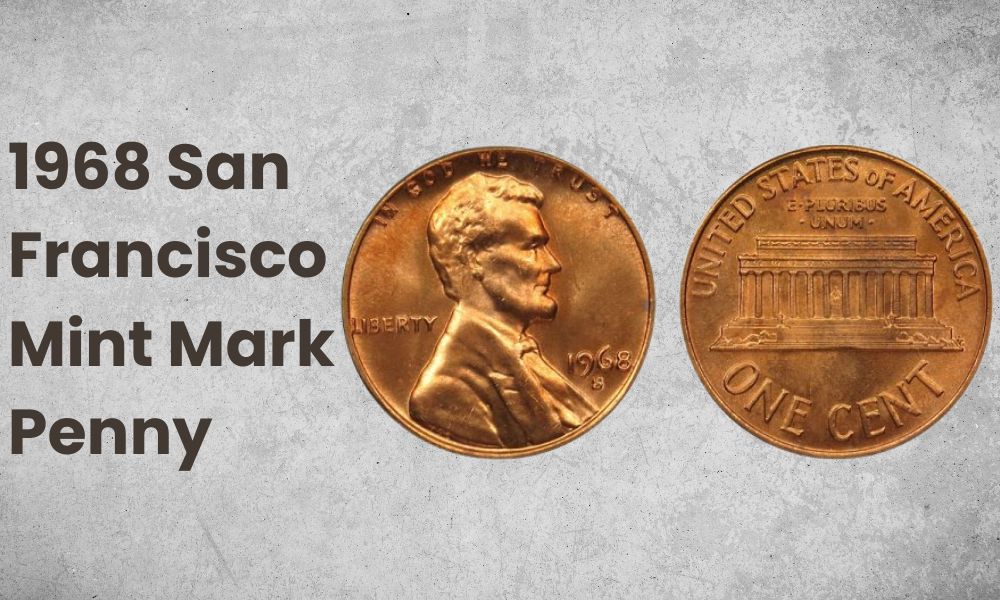
- Type: Penny
- Mark Category: ‘S’ San Francisco Mint Mark
- Materials: 95% copper, 5% zinc
- Edge: Plain
- Mint Mark: “S” for San Francisco
- Place of Minting: United States
- Year of Minting: 1968
- Face Value: $0.01
- Price: From $0.01 to $0.20
- Quantity: 2,933,255,000 minted
- Designer: Victor D. Brenner (obverse), Frank Gasparro (reverse)
- Mass: 3.11 grams
- Diameter: 19.05 mm
In 1968, the San Francisco Mint produced a coin known as the 1968 Mark Penny. The coin is marked with the San Francisco Mint’s “S” initials, proving that it was made there. Its face value is only $0.01, yet 2,933,255,000 1968 San Francisco Mint Mark Pennies were made at that year’s minting, making it one of the most popular pennies from that year. Because of this, it has a poor value and costs just one penny to buy.
The 1968 San Francisco Mint Mark Penny is a popular American currency despite its widespread use, and collectors prize it for its distinctive history and appearance. This coin is a fantastic way to start or add to a collection of pennies. Consider adding this coin to your collection if you’re a collector or just a follower of American history.
1968 Penny History
An important turning point in the history of the currency occurred in 1968 when a new penny was introduced in the United States. The 200th anniversary of Abraham Lincoln’s birth was commemorated on this new penny, which replaced the previous Lincoln cent that had been in use since 1909.
The reverse, or “tails” side, of the 1968 penny was the first penny in American history to have a design on it. The Lincoln Monument, which was finished in 1922 and served as a national memorial to the 16th President of the United States, was featured in this new design.
The composition of the new cent was also noteworthy. Due to increased expenses, the U.S. Mint started moving away from producing pennies entirely out of pure copper in 1962. The copper-plated zinc composition used in the 1968 penny was the first, which made the coin lighter and less expensive to create.
Although the 1968 pennies is significant historically, it is not exceptionally rare or valuable. These coins were made in the millions, and even now, they are still widely used. A well-preserved specimen of this significant piece, particularly one that has been graded by a reputable coin-grading organization, can still be of interest to collectors.
Also Read: Top 20 Most Valuable Old Pennies Worth Money (Penny Collection)
1968 Penny Grading
The condition of the coins is a significant element that might influence their value when it comes to coin collecting. Grading, the act of assessing a coin’s condition and assigning it a numerical grade that indicates its general quality, is where it comes in.
For collectors who want to purchase a high-quality sample of this historic coin, grading can be particularly crucial for the 1968 penny. Like with every coin, the better the condition, the higher the likelihood of value. You can see an example of grading a 1968 penny in this video.
List of 1968 Penny Errors
Double-die obverse
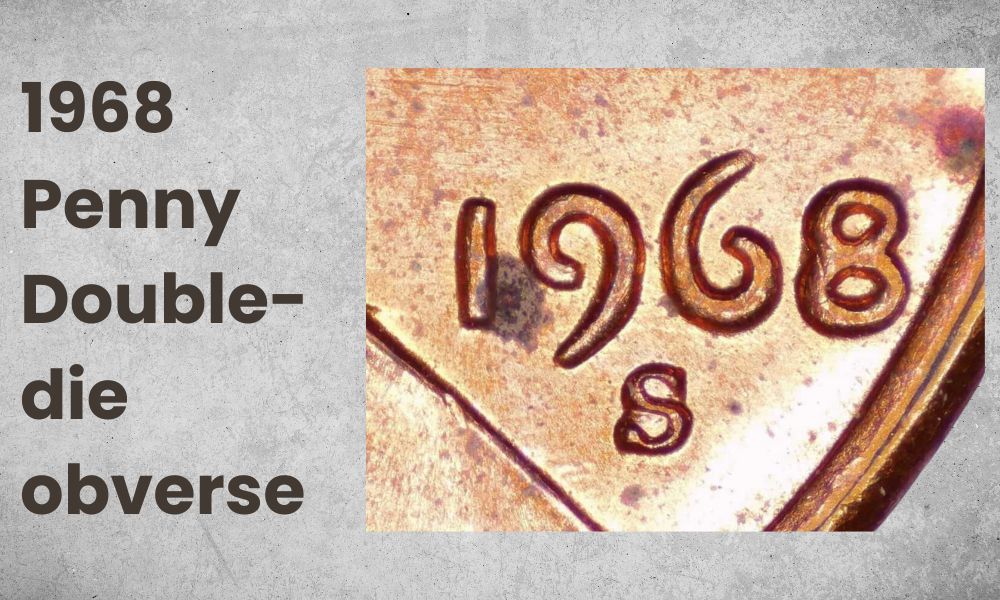
Double-die obverses have a distorted or “doubled” appearance because the coin’s design is stamped twice with slightly off-center impressions. This mistake results from a flaw in the dubbing procedure, where the alignment of the die that stamps the design into the coin is off. Double-die faults are generally quite uncommon, especially on a well-known coin like the 1968 penny.
The 1968 doubled-die Lincoln cent, one of the most expensive coins in American numismatics, is the most well-known instance of a double-die mistake.
Transitional error
A transitional error happens when the mint changes the design or composition of a coin, but some coins are struck with the old design or composition and some with the new design or composition. In 1968, the U.S. The penny’s composition was modified by the Mint from 95% copper to copper-plated zinc.
The old composition was used to strike some coins, while the new composition was used to strike other coins. Rare and precious, especially if they are in a high grade, these transitional errors can be.
Repunched mint mark (RPM)
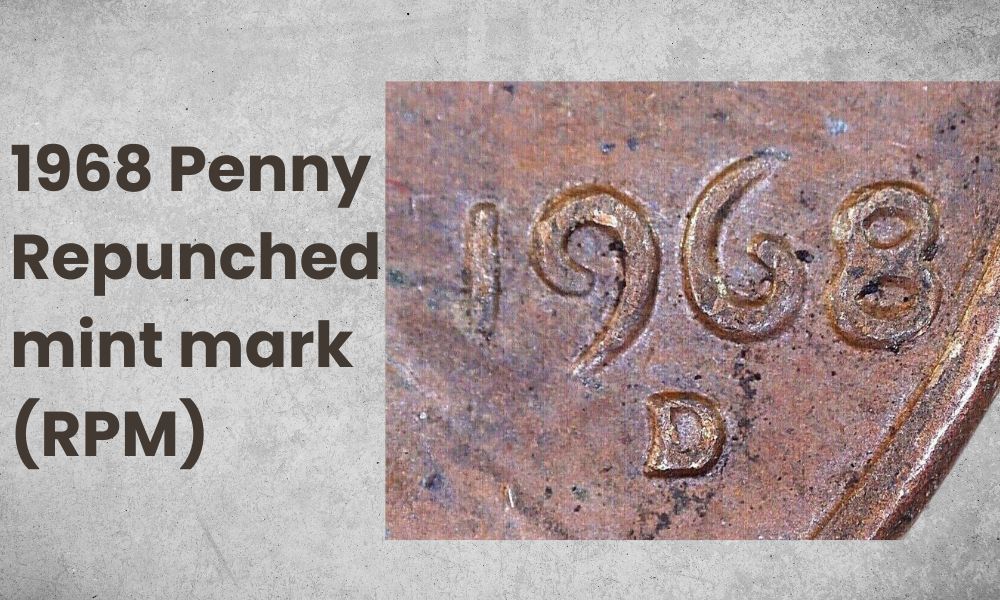
When the mint mark on a coin is stamped more than once, it results in an RPM error and gives the coin a little “ghosted” appearance. Both the “D” (for Denver) and the “S” (for San Francisco) mint marks can be found on the 1968 penny with RPM errors. RPM faults can be fairly unusual, especially if they are in a high grade and have a distinct and obvious mint mark.
Off-center strikes
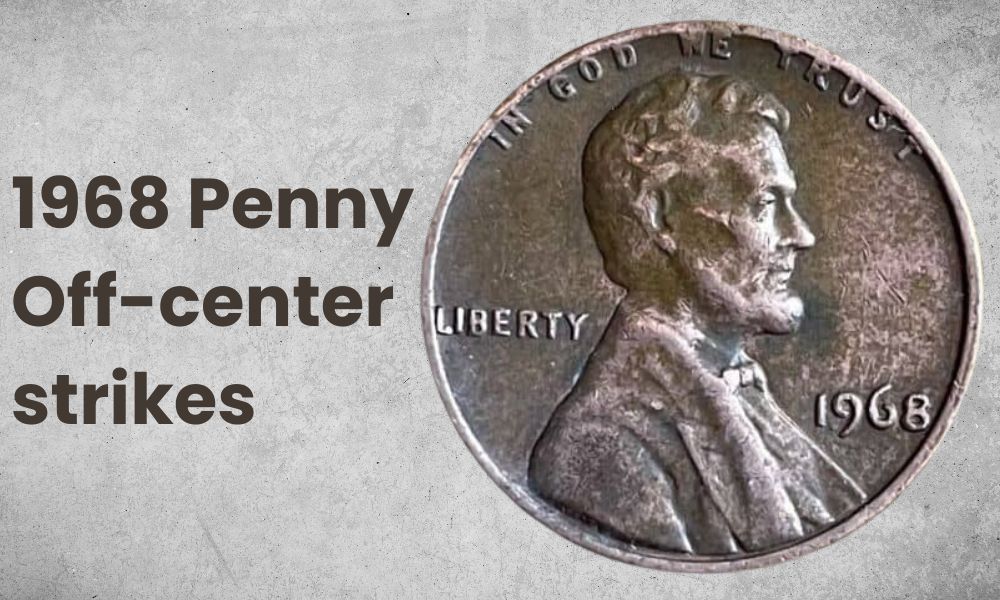
When the design of the coin is struck off-center, it is known as an off-center striking and has an uneven appearance. The degree of misalignment can differ, with some coins having only a slight shift and others having a pronounced one. When well-centered and of a high grade, off-center strikes can be quite unusual and valuable. A coin’s dramatic inaccuracy and potential value increase in direct proportion to how off-center it is.
Die breaks or chips
The metal dies that are used to strike the coins might crack or chip, leaving scratches or other irregularities on the coin’s surface. Die breaks or chips can impact many aspects of the coin’s appearance and come in a variety of sizes and shapes.
Particularly if they are significant or have an impact on an essential component of the design, some die-break faults can be quite unusual and valuable. However, not all die breaks or chips are rare or valuable, and their worth is based on how severe, where they are, and how uncommon they are.
1968 Penny FAQ
Is a 1968 S penny rare?
Although there were approximately 3 billion S pennies produced in 1968, they are not regarded as being uncommon. On the 1968 S penny, there are a few uncommon faults that can be detected, like a double-die obverse or an RPM error, which can be highly expensive.
Why is a 1968 D penny worth so much?
The 1968 D penny does not always have a higher value than other 1968 pennies. An RPM error or double-die obverse on a 1968 D penny, however, can make the coin highly valuable. A coin’s value may also be impacted by its condition.
What is the error in the 1968 penny?
A 1968 penny has a number of flaws, including a double-die obverse, a transitional error, an RPM error, off-center striking, and die splits or chips. The most prominent and uncommon mistake is the double-die obverse, which results from an issue with the dubbing process and distorts or appears “doubled” on the coin’s design.
Why are 1968 pennies more valuable than 1967 pennies?
It’s not always the case that 1968 pennies are worth more than 1967 ones. Nonetheless, some uncommon flaws on 1968 pennies, such as the double-die obverse or RPM mistake, might increase their value relative to 1967 pennies. The coin’s condition might also have an impact on its value.
